Analysis of Contractual Elements and Liabilities - Law Module
VerifiedAdded on 2019/12/03
|12
|3866
|93
Report
AI Summary
This report delves into the multifaceted aspects of contract law, providing a comprehensive analysis of its core elements and implications in business contexts. The report begins by outlining the essential elements required for the formation of a valid contract, including offer, acceptance, consideration, and the intention to create legal relations. It then explores the impact of various contract types, such as oral, written, distance, and face-to-face contracts, highlighting their unique characteristics and legal interpretations. The analysis further extends to the examination of contract terms, distinguishing between express and implied terms, and the significance of in-nominate terms. The report applies these contractual principles to real-world business scenarios, assessing issues of offer and acceptance, unilateral contracts, and the impact of exclusion clauses. Furthermore, the report contrasts liability between contract and tort law, including negligence and employers’ liability, and assesses the concept of vicarious liability in given circumstances. Through case explanations and practical applications, the report provides a solid understanding of contract law and its implications.

Aspects of
contracts
contracts
Paraphrase This Document
Need a fresh take? Get an instant paraphrase of this document with our AI Paraphraser
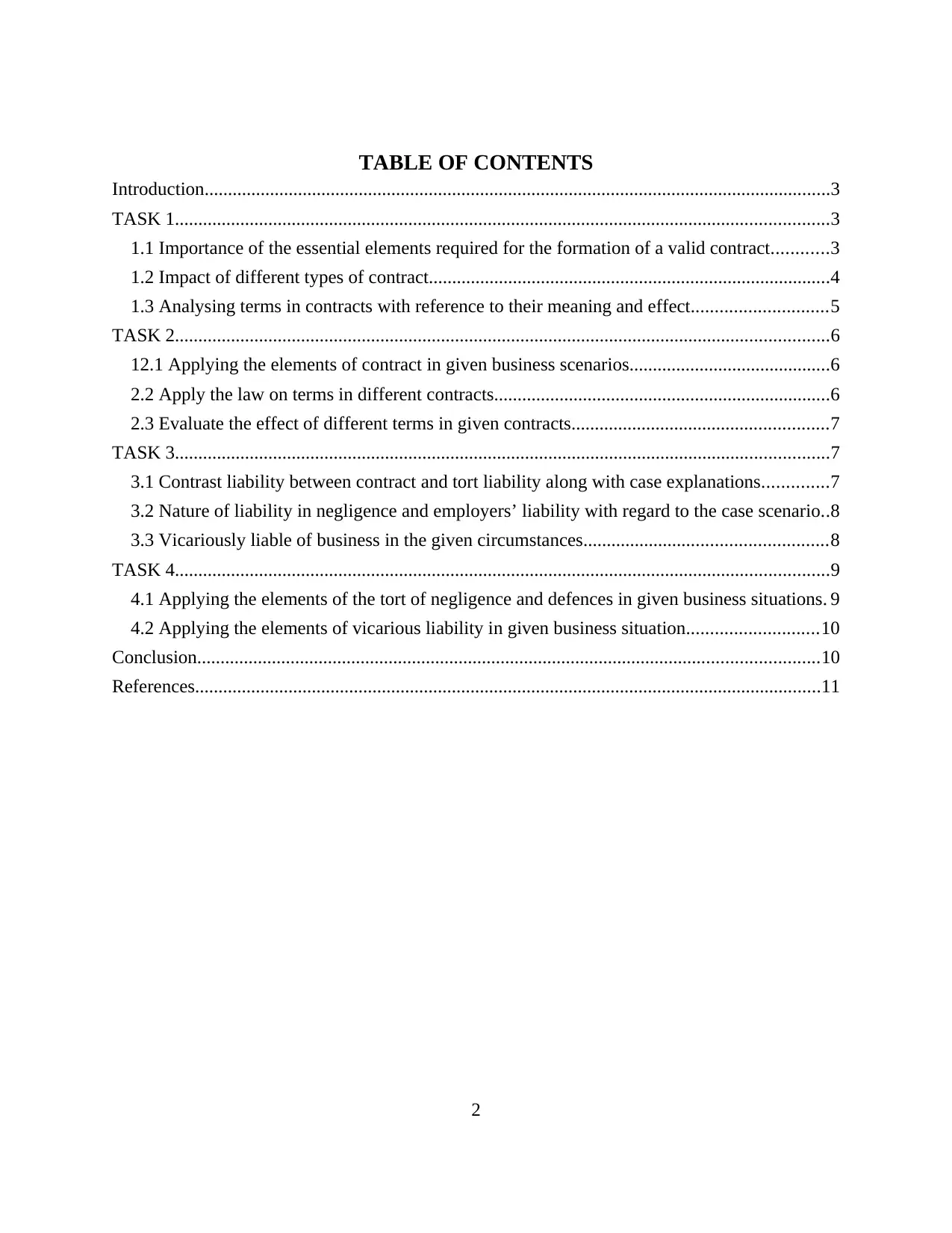
TABLE OF CONTENTS
Introduction......................................................................................................................................3
TASK 1............................................................................................................................................3
1.1 Importance of the essential elements required for the formation of a valid contract............3
1.2 Impact of different types of contract......................................................................................4
1.3 Analysing terms in contracts with reference to their meaning and effect.............................5
TASK 2............................................................................................................................................6
12.1 Applying the elements of contract in given business scenarios...........................................6
2.2 Apply the law on terms in different contracts........................................................................6
2.3 Evaluate the effect of different terms in given contracts.......................................................7
TASK 3............................................................................................................................................7
3.1 Contrast liability between contract and tort liability along with case explanations..............7
3.2 Nature of liability in negligence and employers’ liability with regard to the case scenario..8
3.3 Vicariously liable of business in the given circumstances....................................................8
TASK 4............................................................................................................................................9
4.1 Applying the elements of the tort of negligence and defences in given business situations. 9
4.2 Applying the elements of vicarious liability in given business situation............................10
Conclusion.....................................................................................................................................10
References......................................................................................................................................11
2
Introduction......................................................................................................................................3
TASK 1............................................................................................................................................3
1.1 Importance of the essential elements required for the formation of a valid contract............3
1.2 Impact of different types of contract......................................................................................4
1.3 Analysing terms in contracts with reference to their meaning and effect.............................5
TASK 2............................................................................................................................................6
12.1 Applying the elements of contract in given business scenarios...........................................6
2.2 Apply the law on terms in different contracts........................................................................6
2.3 Evaluate the effect of different terms in given contracts.......................................................7
TASK 3............................................................................................................................................7
3.1 Contrast liability between contract and tort liability along with case explanations..............7
3.2 Nature of liability in negligence and employers’ liability with regard to the case scenario..8
3.3 Vicariously liable of business in the given circumstances....................................................8
TASK 4............................................................................................................................................9
4.1 Applying the elements of the tort of negligence and defences in given business situations. 9
4.2 Applying the elements of vicarious liability in given business situation............................10
Conclusion.....................................................................................................................................10
References......................................................................................................................................11
2
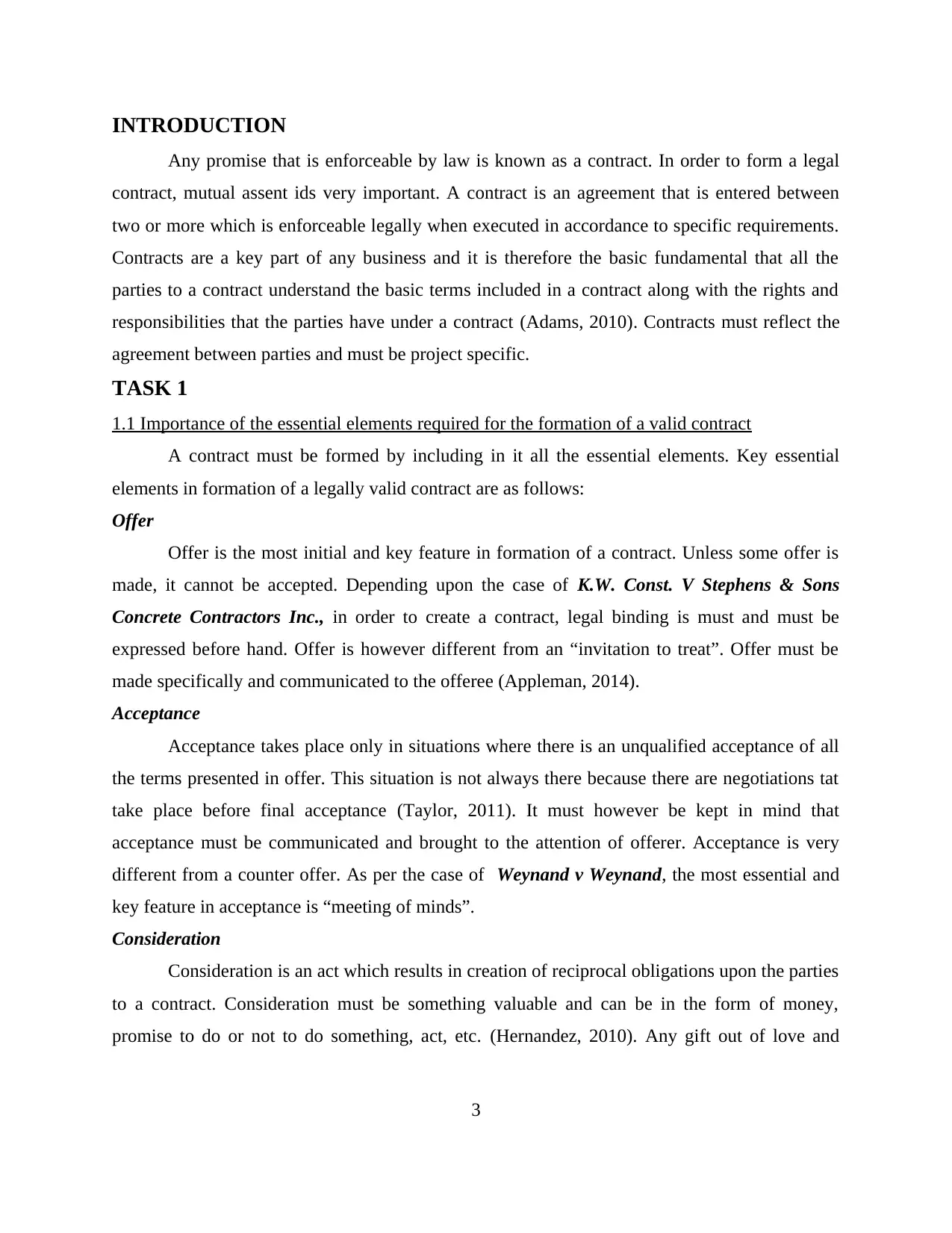
INTRODUCTION
Any promise that is enforceable by law is known as a contract. In order to form a legal
contract, mutual assent ids very important. A contract is an agreement that is entered between
two or more which is enforceable legally when executed in accordance to specific requirements.
Contracts are a key part of any business and it is therefore the basic fundamental that all the
parties to a contract understand the basic terms included in a contract along with the rights and
responsibilities that the parties have under a contract (Adams, 2010). Contracts must reflect the
agreement between parties and must be project specific.
TASK 1
1.1 Importance of the essential elements required for the formation of a valid contract
A contract must be formed by including in it all the essential elements. Key essential
elements in formation of a legally valid contract are as follows:
Offer
Offer is the most initial and key feature in formation of a contract. Unless some offer is
made, it cannot be accepted. Depending upon the case of K.W. Const. V Stephens & Sons
Concrete Contractors Inc., in order to create a contract, legal binding is must and must be
expressed before hand. Offer is however different from an “invitation to treat”. Offer must be
made specifically and communicated to the offeree (Appleman, 2014).
Acceptance
Acceptance takes place only in situations where there is an unqualified acceptance of all
the terms presented in offer. This situation is not always there because there are negotiations tat
take place before final acceptance (Taylor, 2011). It must however be kept in mind that
acceptance must be communicated and brought to the attention of offerer. Acceptance is very
different from a counter offer. As per the case of Weynand v Weynand, the most essential and
key feature in acceptance is “meeting of minds”.
Consideration
Consideration is an act which results in creation of reciprocal obligations upon the parties
to a contract. Consideration must be something valuable and can be in the form of money,
promise to do or not to do something, act, etc. (Hernandez, 2010). Any gift out of love and
3
Any promise that is enforceable by law is known as a contract. In order to form a legal
contract, mutual assent ids very important. A contract is an agreement that is entered between
two or more which is enforceable legally when executed in accordance to specific requirements.
Contracts are a key part of any business and it is therefore the basic fundamental that all the
parties to a contract understand the basic terms included in a contract along with the rights and
responsibilities that the parties have under a contract (Adams, 2010). Contracts must reflect the
agreement between parties and must be project specific.
TASK 1
1.1 Importance of the essential elements required for the formation of a valid contract
A contract must be formed by including in it all the essential elements. Key essential
elements in formation of a legally valid contract are as follows:
Offer
Offer is the most initial and key feature in formation of a contract. Unless some offer is
made, it cannot be accepted. Depending upon the case of K.W. Const. V Stephens & Sons
Concrete Contractors Inc., in order to create a contract, legal binding is must and must be
expressed before hand. Offer is however different from an “invitation to treat”. Offer must be
made specifically and communicated to the offeree (Appleman, 2014).
Acceptance
Acceptance takes place only in situations where there is an unqualified acceptance of all
the terms presented in offer. This situation is not always there because there are negotiations tat
take place before final acceptance (Taylor, 2011). It must however be kept in mind that
acceptance must be communicated and brought to the attention of offerer. Acceptance is very
different from a counter offer. As per the case of Weynand v Weynand, the most essential and
key feature in acceptance is “meeting of minds”.
Consideration
Consideration is an act which results in creation of reciprocal obligations upon the parties
to a contract. Consideration must be something valuable and can be in the form of money,
promise to do or not to do something, act, etc. (Hernandez, 2010). Any gift out of love and
3
⊘ This is a preview!⊘
Do you want full access?
Subscribe today to unlock all pages.

Trusted by 1+ million students worldwide
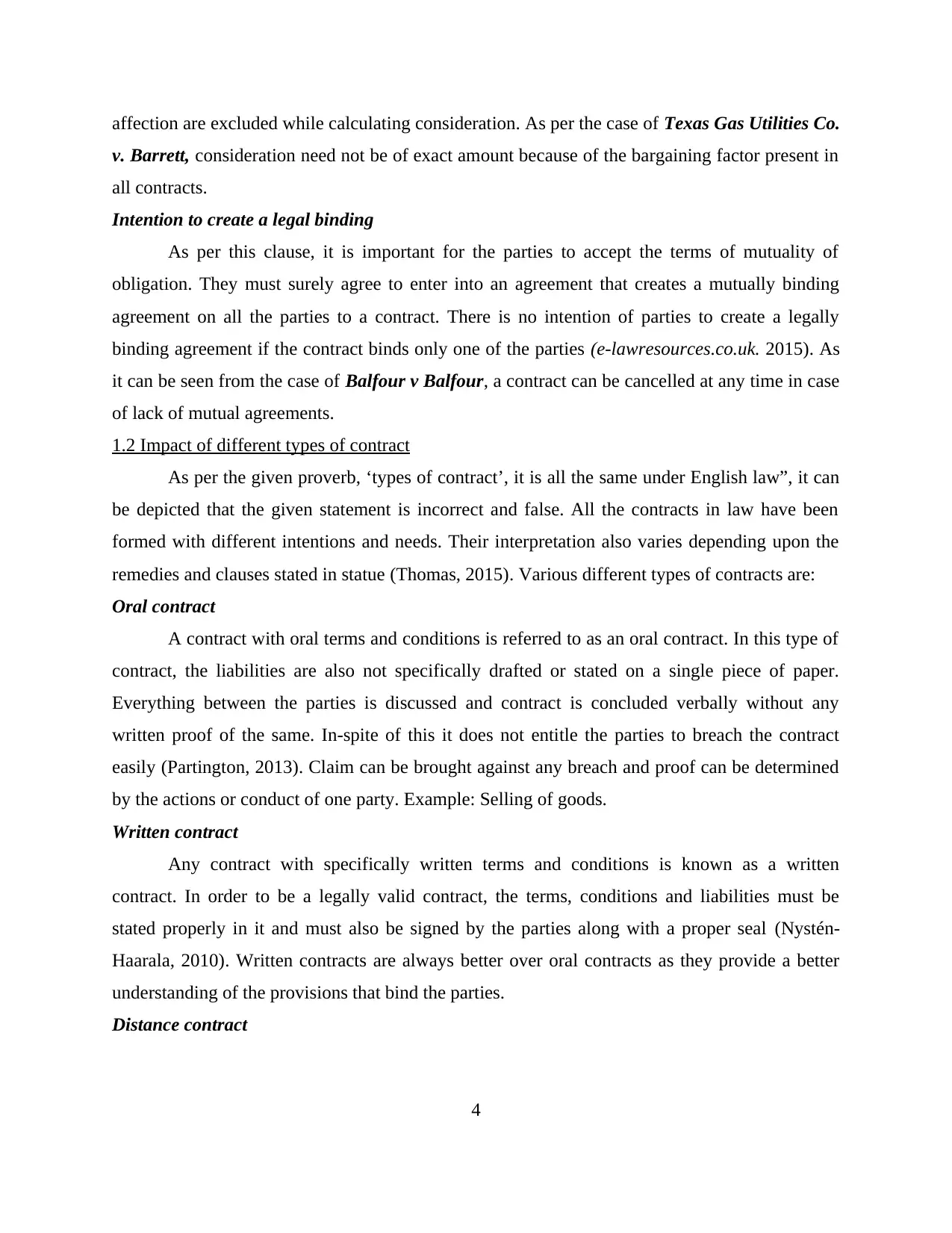
affection are excluded while calculating consideration. As per the case of Texas Gas Utilities Co.
v. Barrett, consideration need not be of exact amount because of the bargaining factor present in
all contracts.
Intention to create a legal binding
As per this clause, it is important for the parties to accept the terms of mutuality of
obligation. They must surely agree to enter into an agreement that creates a mutually binding
agreement on all the parties to a contract. There is no intention of parties to create a legally
binding agreement if the contract binds only one of the parties (e-lawresources.co.uk. 2015). As
it can be seen from the case of Balfour v Balfour, a contract can be cancelled at any time in case
of lack of mutual agreements.
1.2 Impact of different types of contract
As per the given proverb, ‘types of contract’, it is all the same under English law”, it can
be depicted that the given statement is incorrect and false. All the contracts in law have been
formed with different intentions and needs. Their interpretation also varies depending upon the
remedies and clauses stated in statue (Thomas, 2015). Various different types of contracts are:
Oral contract
A contract with oral terms and conditions is referred to as an oral contract. In this type of
contract, the liabilities are also not specifically drafted or stated on a single piece of paper.
Everything between the parties is discussed and contract is concluded verbally without any
written proof of the same. In-spite of this it does not entitle the parties to breach the contract
easily (Partington, 2013). Claim can be brought against any breach and proof can be determined
by the actions or conduct of one party. Example: Selling of goods.
Written contract
Any contract with specifically written terms and conditions is known as a written
contract. In order to be a legally valid contract, the terms, conditions and liabilities must be
stated properly in it and must also be signed by the parties along with a proper seal (Nystén-
Haarala, 2010). Written contracts are always better over oral contracts as they provide a better
understanding of the provisions that bind the parties.
Distance contract
4
v. Barrett, consideration need not be of exact amount because of the bargaining factor present in
all contracts.
Intention to create a legal binding
As per this clause, it is important for the parties to accept the terms of mutuality of
obligation. They must surely agree to enter into an agreement that creates a mutually binding
agreement on all the parties to a contract. There is no intention of parties to create a legally
binding agreement if the contract binds only one of the parties (e-lawresources.co.uk. 2015). As
it can be seen from the case of Balfour v Balfour, a contract can be cancelled at any time in case
of lack of mutual agreements.
1.2 Impact of different types of contract
As per the given proverb, ‘types of contract’, it is all the same under English law”, it can
be depicted that the given statement is incorrect and false. All the contracts in law have been
formed with different intentions and needs. Their interpretation also varies depending upon the
remedies and clauses stated in statue (Thomas, 2015). Various different types of contracts are:
Oral contract
A contract with oral terms and conditions is referred to as an oral contract. In this type of
contract, the liabilities are also not specifically drafted or stated on a single piece of paper.
Everything between the parties is discussed and contract is concluded verbally without any
written proof of the same. In-spite of this it does not entitle the parties to breach the contract
easily (Partington, 2013). Claim can be brought against any breach and proof can be determined
by the actions or conduct of one party. Example: Selling of goods.
Written contract
Any contract with specifically written terms and conditions is known as a written
contract. In order to be a legally valid contract, the terms, conditions and liabilities must be
stated properly in it and must also be signed by the parties along with a proper seal (Nystén-
Haarala, 2010). Written contracts are always better over oral contracts as they provide a better
understanding of the provisions that bind the parties.
Distance contract
4
Paraphrase This Document
Need a fresh take? Get an instant paraphrase of this document with our AI Paraphraser
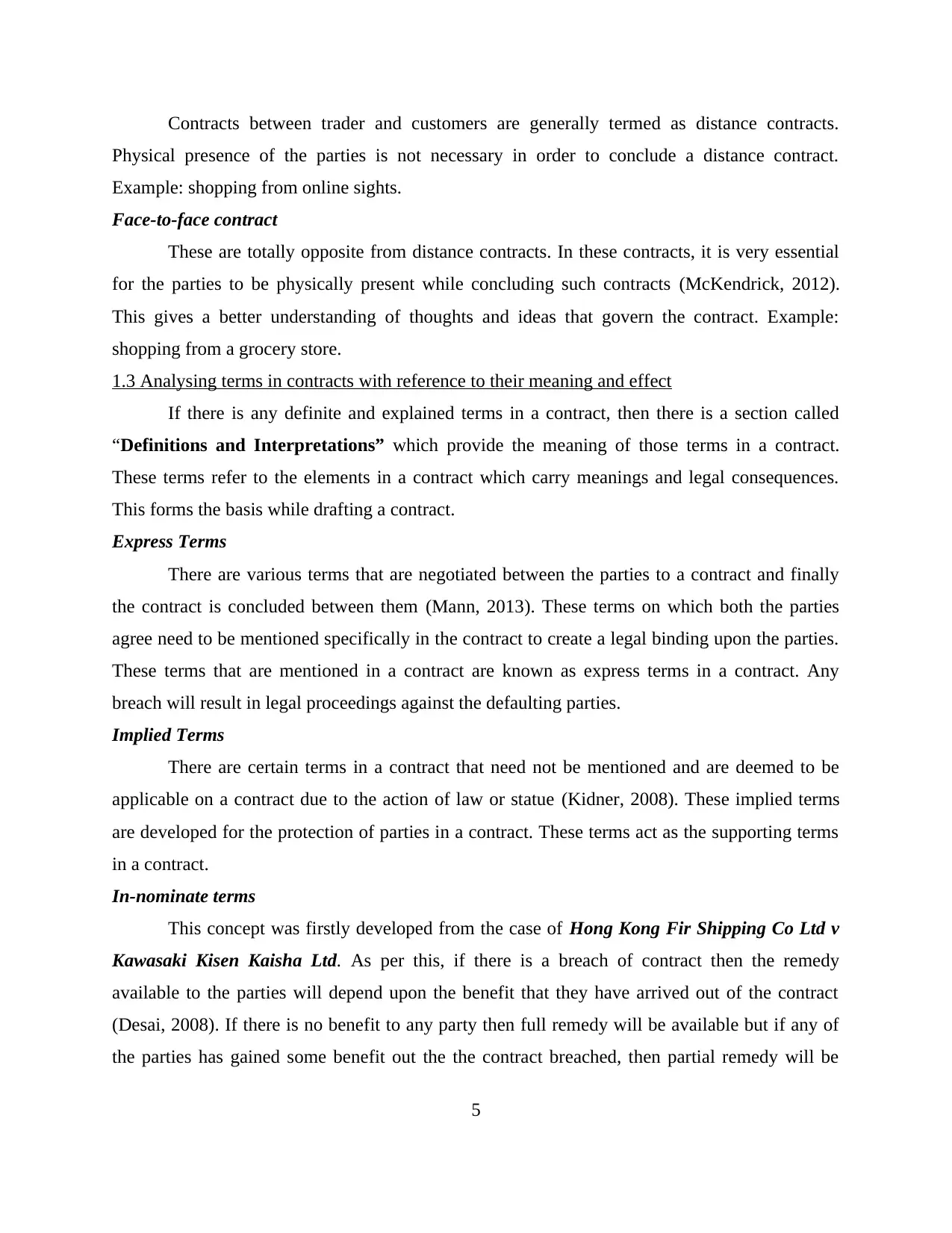
Contracts between trader and customers are generally termed as distance contracts.
Physical presence of the parties is not necessary in order to conclude a distance contract.
Example: shopping from online sights.
Face-to-face contract
These are totally opposite from distance contracts. In these contracts, it is very essential
for the parties to be physically present while concluding such contracts (McKendrick, 2012).
This gives a better understanding of thoughts and ideas that govern the contract. Example:
shopping from a grocery store.
1.3 Analysing terms in contracts with reference to their meaning and effect
If there is any definite and explained terms in a contract, then there is a section called
“Definitions and Interpretations” which provide the meaning of those terms in a contract.
These terms refer to the elements in a contract which carry meanings and legal consequences.
This forms the basis while drafting a contract.
Express Terms
There are various terms that are negotiated between the parties to a contract and finally
the contract is concluded between them (Mann, 2013). These terms on which both the parties
agree need to be mentioned specifically in the contract to create a legal binding upon the parties.
These terms that are mentioned in a contract are known as express terms in a contract. Any
breach will result in legal proceedings against the defaulting parties.
Implied Terms
There are certain terms in a contract that need not be mentioned and are deemed to be
applicable on a contract due to the action of law or statue (Kidner, 2008). These implied terms
are developed for the protection of parties in a contract. These terms act as the supporting terms
in a contract.
In-nominate terms
This concept was firstly developed from the case of Hong Kong Fir Shipping Co Ltd v
Kawasaki Kisen Kaisha Ltd. As per this, if there is a breach of contract then the remedy
available to the parties will depend upon the benefit that they have arrived out of the contract
(Desai, 2008). If there is no benefit to any party then full remedy will be available but if any of
the parties has gained some benefit out the the contract breached, then partial remedy will be
5
Physical presence of the parties is not necessary in order to conclude a distance contract.
Example: shopping from online sights.
Face-to-face contract
These are totally opposite from distance contracts. In these contracts, it is very essential
for the parties to be physically present while concluding such contracts (McKendrick, 2012).
This gives a better understanding of thoughts and ideas that govern the contract. Example:
shopping from a grocery store.
1.3 Analysing terms in contracts with reference to their meaning and effect
If there is any definite and explained terms in a contract, then there is a section called
“Definitions and Interpretations” which provide the meaning of those terms in a contract.
These terms refer to the elements in a contract which carry meanings and legal consequences.
This forms the basis while drafting a contract.
Express Terms
There are various terms that are negotiated between the parties to a contract and finally
the contract is concluded between them (Mann, 2013). These terms on which both the parties
agree need to be mentioned specifically in the contract to create a legal binding upon the parties.
These terms that are mentioned in a contract are known as express terms in a contract. Any
breach will result in legal proceedings against the defaulting parties.
Implied Terms
There are certain terms in a contract that need not be mentioned and are deemed to be
applicable on a contract due to the action of law or statue (Kidner, 2008). These implied terms
are developed for the protection of parties in a contract. These terms act as the supporting terms
in a contract.
In-nominate terms
This concept was firstly developed from the case of Hong Kong Fir Shipping Co Ltd v
Kawasaki Kisen Kaisha Ltd. As per this, if there is a breach of contract then the remedy
available to the parties will depend upon the benefit that they have arrived out of the contract
(Desai, 2008). If there is no benefit to any party then full remedy will be available but if any of
the parties has gained some benefit out the the contract breached, then partial remedy will be
5
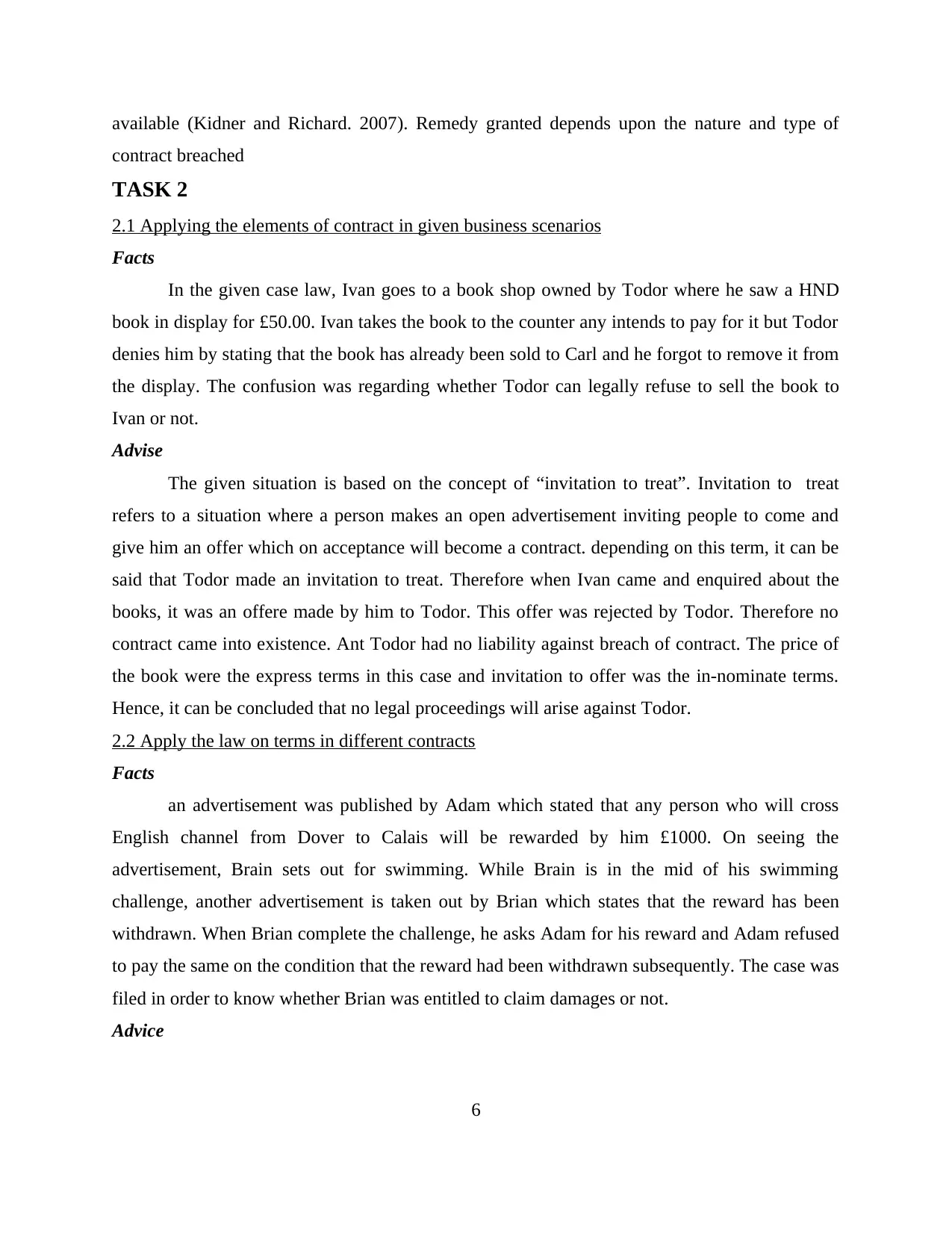
available (Kidner and Richard. 2007). Remedy granted depends upon the nature and type of
contract breached
TASK 2
2.1 Applying the elements of contract in given business scenarios
Facts
In the given case law, Ivan goes to a book shop owned by Todor where he saw a HND
book in display for £50.00. Ivan takes the book to the counter any intends to pay for it but Todor
denies him by stating that the book has already been sold to Carl and he forgot to remove it from
the display. The confusion was regarding whether Todor can legally refuse to sell the book to
Ivan or not.
Advise
The given situation is based on the concept of “invitation to treat”. Invitation to treat
refers to a situation where a person makes an open advertisement inviting people to come and
give him an offer which on acceptance will become a contract. depending on this term, it can be
said that Todor made an invitation to treat. Therefore when Ivan came and enquired about the
books, it was an offere made by him to Todor. This offer was rejected by Todor. Therefore no
contract came into existence. Ant Todor had no liability against breach of contract. The price of
the book were the express terms in this case and invitation to offer was the in-nominate terms.
Hence, it can be concluded that no legal proceedings will arise against Todor.
2.2 Apply the law on terms in different contracts
Facts
an advertisement was published by Adam which stated that any person who will cross
English channel from Dover to Calais will be rewarded by him £1000. On seeing the
advertisement, Brain sets out for swimming. While Brain is in the mid of his swimming
challenge, another advertisement is taken out by Brian which states that the reward has been
withdrawn. When Brian complete the challenge, he asks Adam for his reward and Adam refused
to pay the same on the condition that the reward had been withdrawn subsequently. The case was
filed in order to know whether Brian was entitled to claim damages or not.
Advice
6
contract breached
TASK 2
2.1 Applying the elements of contract in given business scenarios
Facts
In the given case law, Ivan goes to a book shop owned by Todor where he saw a HND
book in display for £50.00. Ivan takes the book to the counter any intends to pay for it but Todor
denies him by stating that the book has already been sold to Carl and he forgot to remove it from
the display. The confusion was regarding whether Todor can legally refuse to sell the book to
Ivan or not.
Advise
The given situation is based on the concept of “invitation to treat”. Invitation to treat
refers to a situation where a person makes an open advertisement inviting people to come and
give him an offer which on acceptance will become a contract. depending on this term, it can be
said that Todor made an invitation to treat. Therefore when Ivan came and enquired about the
books, it was an offere made by him to Todor. This offer was rejected by Todor. Therefore no
contract came into existence. Ant Todor had no liability against breach of contract. The price of
the book were the express terms in this case and invitation to offer was the in-nominate terms.
Hence, it can be concluded that no legal proceedings will arise against Todor.
2.2 Apply the law on terms in different contracts
Facts
an advertisement was published by Adam which stated that any person who will cross
English channel from Dover to Calais will be rewarded by him £1000. On seeing the
advertisement, Brain sets out for swimming. While Brain is in the mid of his swimming
challenge, another advertisement is taken out by Brian which states that the reward has been
withdrawn. When Brian complete the challenge, he asks Adam for his reward and Adam refused
to pay the same on the condition that the reward had been withdrawn subsequently. The case was
filed in order to know whether Brian was entitled to claim damages or not.
Advice
6
⊘ This is a preview!⊘
Do you want full access?
Subscribe today to unlock all pages.

Trusted by 1+ million students worldwide
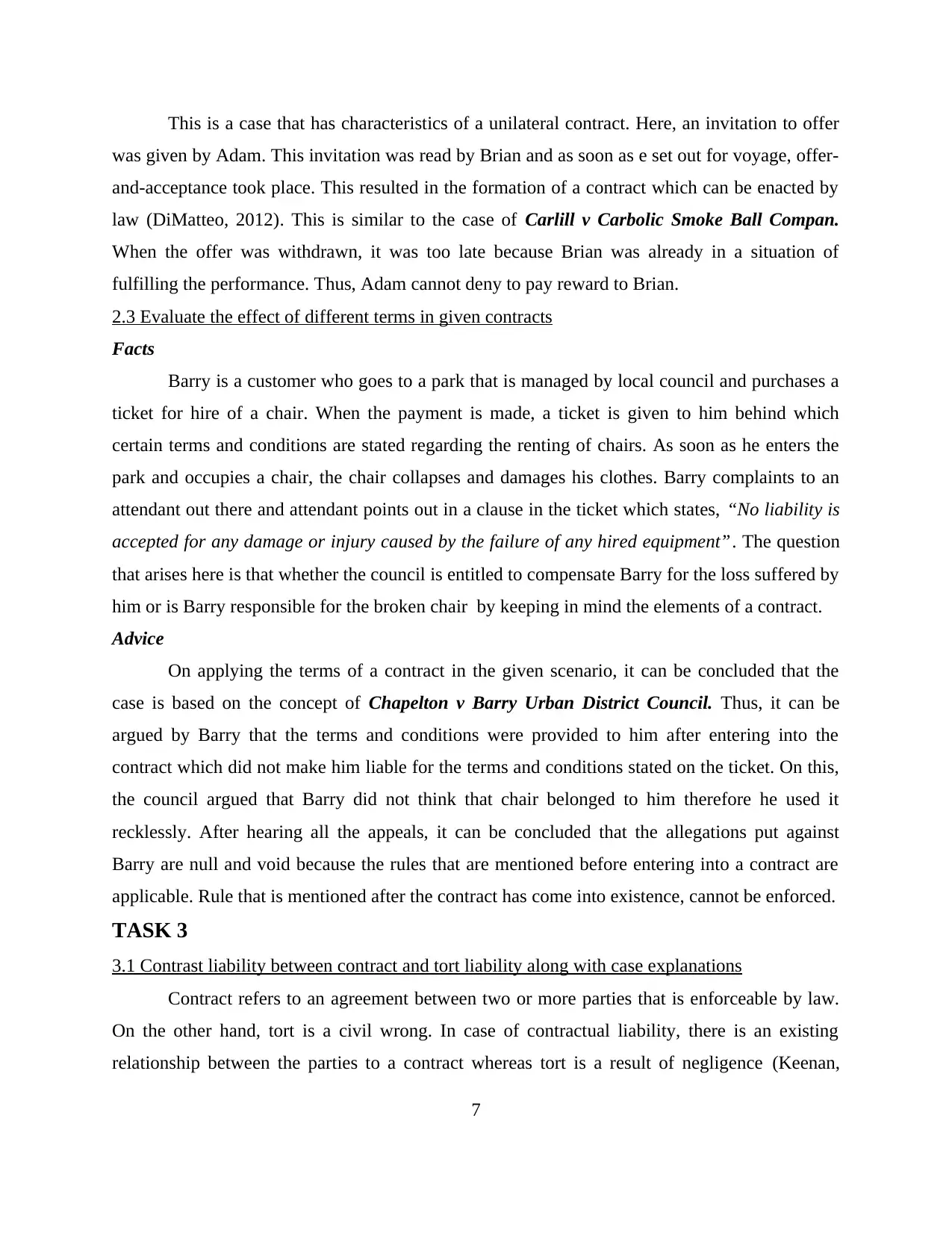
This is a case that has characteristics of a unilateral contract. Here, an invitation to offer
was given by Adam. This invitation was read by Brian and as soon as e set out for voyage, offer-
and-acceptance took place. This resulted in the formation of a contract which can be enacted by
law (DiMatteo, 2012). This is similar to the case of Carlill v Carbolic Smoke Ball Compan.
When the offer was withdrawn, it was too late because Brian was already in a situation of
fulfilling the performance. Thus, Adam cannot deny to pay reward to Brian.
2.3 Evaluate the effect of different terms in given contracts
Facts
Barry is a customer who goes to a park that is managed by local council and purchases a
ticket for hire of a chair. When the payment is made, a ticket is given to him behind which
certain terms and conditions are stated regarding the renting of chairs. As soon as he enters the
park and occupies a chair, the chair collapses and damages his clothes. Barry complaints to an
attendant out there and attendant points out in a clause in the ticket which states, “No liability is
accepted for any damage or injury caused by the failure of any hired equipment”. The question
that arises here is that whether the council is entitled to compensate Barry for the loss suffered by
him or is Barry responsible for the broken chair by keeping in mind the elements of a contract.
Advice
On applying the terms of a contract in the given scenario, it can be concluded that the
case is based on the concept of Chapelton v Barry Urban District Council. Thus, it can be
argued by Barry that the terms and conditions were provided to him after entering into the
contract which did not make him liable for the terms and conditions stated on the ticket. On this,
the council argued that Barry did not think that chair belonged to him therefore he used it
recklessly. After hearing all the appeals, it can be concluded that the allegations put against
Barry are null and void because the rules that are mentioned before entering into a contract are
applicable. Rule that is mentioned after the contract has come into existence, cannot be enforced.
TASK 3
3.1 Contrast liability between contract and tort liability along with case explanations
Contract refers to an agreement between two or more parties that is enforceable by law.
On the other hand, tort is a civil wrong. In case of contractual liability, there is an existing
relationship between the parties to a contract whereas tort is a result of negligence (Keenan,
7
was given by Adam. This invitation was read by Brian and as soon as e set out for voyage, offer-
and-acceptance took place. This resulted in the formation of a contract which can be enacted by
law (DiMatteo, 2012). This is similar to the case of Carlill v Carbolic Smoke Ball Compan.
When the offer was withdrawn, it was too late because Brian was already in a situation of
fulfilling the performance. Thus, Adam cannot deny to pay reward to Brian.
2.3 Evaluate the effect of different terms in given contracts
Facts
Barry is a customer who goes to a park that is managed by local council and purchases a
ticket for hire of a chair. When the payment is made, a ticket is given to him behind which
certain terms and conditions are stated regarding the renting of chairs. As soon as he enters the
park and occupies a chair, the chair collapses and damages his clothes. Barry complaints to an
attendant out there and attendant points out in a clause in the ticket which states, “No liability is
accepted for any damage or injury caused by the failure of any hired equipment”. The question
that arises here is that whether the council is entitled to compensate Barry for the loss suffered by
him or is Barry responsible for the broken chair by keeping in mind the elements of a contract.
Advice
On applying the terms of a contract in the given scenario, it can be concluded that the
case is based on the concept of Chapelton v Barry Urban District Council. Thus, it can be
argued by Barry that the terms and conditions were provided to him after entering into the
contract which did not make him liable for the terms and conditions stated on the ticket. On this,
the council argued that Barry did not think that chair belonged to him therefore he used it
recklessly. After hearing all the appeals, it can be concluded that the allegations put against
Barry are null and void because the rules that are mentioned before entering into a contract are
applicable. Rule that is mentioned after the contract has come into existence, cannot be enforced.
TASK 3
3.1 Contrast liability between contract and tort liability along with case explanations
Contract refers to an agreement between two or more parties that is enforceable by law.
On the other hand, tort is a civil wrong. In case of contractual liability, there is an existing
relationship between the parties to a contract whereas tort is a result of negligence (Keenan,
7
Paraphrase This Document
Need a fresh take? Get an instant paraphrase of this document with our AI Paraphraser
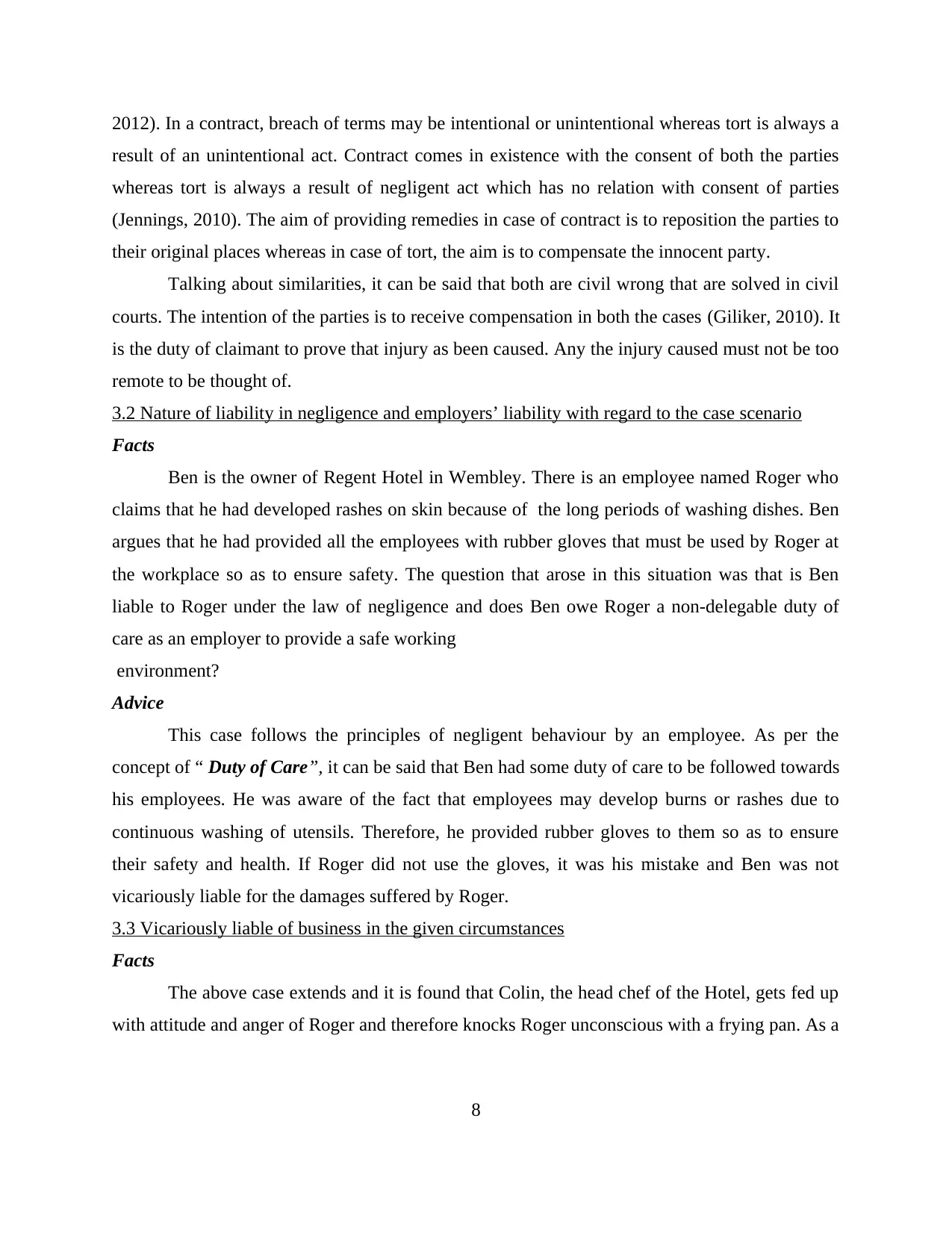
2012). In a contract, breach of terms may be intentional or unintentional whereas tort is always a
result of an unintentional act. Contract comes in existence with the consent of both the parties
whereas tort is always a result of negligent act which has no relation with consent of parties
(Jennings, 2010). The aim of providing remedies in case of contract is to reposition the parties to
their original places whereas in case of tort, the aim is to compensate the innocent party.
Talking about similarities, it can be said that both are civil wrong that are solved in civil
courts. The intention of the parties is to receive compensation in both the cases (Giliker, 2010). It
is the duty of claimant to prove that injury as been caused. Any the injury caused must not be too
remote to be thought of.
3.2 Nature of liability in negligence and employers’ liability with regard to the case scenario
Facts
Ben is the owner of Regent Hotel in Wembley. There is an employee named Roger who
claims that he had developed rashes on skin because of the long periods of washing dishes. Ben
argues that he had provided all the employees with rubber gloves that must be used by Roger at
the workplace so as to ensure safety. The question that arose in this situation was that is Ben
liable to Roger under the law of negligence and does Ben owe Roger a non-delegable duty of
care as an employer to provide a safe working
environment?
Advice
This case follows the principles of negligent behaviour by an employee. As per the
concept of “ Duty of Care”, it can be said that Ben had some duty of care to be followed towards
his employees. He was aware of the fact that employees may develop burns or rashes due to
continuous washing of utensils. Therefore, he provided rubber gloves to them so as to ensure
their safety and health. If Roger did not use the gloves, it was his mistake and Ben was not
vicariously liable for the damages suffered by Roger.
3.3 Vicariously liable of business in the given circumstances
Facts
The above case extends and it is found that Colin, the head chef of the Hotel, gets fed up
with attitude and anger of Roger and therefore knocks Roger unconscious with a frying pan. As a
8
result of an unintentional act. Contract comes in existence with the consent of both the parties
whereas tort is always a result of negligent act which has no relation with consent of parties
(Jennings, 2010). The aim of providing remedies in case of contract is to reposition the parties to
their original places whereas in case of tort, the aim is to compensate the innocent party.
Talking about similarities, it can be said that both are civil wrong that are solved in civil
courts. The intention of the parties is to receive compensation in both the cases (Giliker, 2010). It
is the duty of claimant to prove that injury as been caused. Any the injury caused must not be too
remote to be thought of.
3.2 Nature of liability in negligence and employers’ liability with regard to the case scenario
Facts
Ben is the owner of Regent Hotel in Wembley. There is an employee named Roger who
claims that he had developed rashes on skin because of the long periods of washing dishes. Ben
argues that he had provided all the employees with rubber gloves that must be used by Roger at
the workplace so as to ensure safety. The question that arose in this situation was that is Ben
liable to Roger under the law of negligence and does Ben owe Roger a non-delegable duty of
care as an employer to provide a safe working
environment?
Advice
This case follows the principles of negligent behaviour by an employee. As per the
concept of “ Duty of Care”, it can be said that Ben had some duty of care to be followed towards
his employees. He was aware of the fact that employees may develop burns or rashes due to
continuous washing of utensils. Therefore, he provided rubber gloves to them so as to ensure
their safety and health. If Roger did not use the gloves, it was his mistake and Ben was not
vicariously liable for the damages suffered by Roger.
3.3 Vicariously liable of business in the given circumstances
Facts
The above case extends and it is found that Colin, the head chef of the Hotel, gets fed up
with attitude and anger of Roger and therefore knocks Roger unconscious with a frying pan. As a
8

result Roger gets severely injured and despite of that refuses to go to the hospital. The concern
here was that can Roger bring a claim in vicarious liability
against Ben for Colin’s actions? Does Roger sue Colin?
Advice
As per the law of vicarious liability, it can be concluded that (1) Ben was the owner of
the hotel and was liable for all the acts of his subordinates in the course of employment. It was
his duty to ensure that no employee uses non required force against other employees. Also, when
Roger denied to go to the hospital, he committed an act of contributory negligence. Thus, in this
case both Ben and Roger will be at fault. (2) Colin was at fault while beating Roger. He must
have made initiatives to make Roger understand that what impact his behaviour was having on
the Hotel instead of using force against him. Thus, a claim for vicarious liability can be brought
by Roger against Colin.
TASK 4
Facts of the task
It is stated that Mark was a frequent guest of Regent Hotel. While his stay in the hotel he
decided to go to the pool for swimming. On his way to the pool, he came across a board saying,
‘Pool closed between 7.00pm and 7.00 am. No entry to visitors during these hours; ‘Dangerous
when unattended’. He still ignores the instructions and jumps in the pool. It was very dark so e
could not notice that the pool was empty. Due to this he was injured badly and also broke his
expensive designer sunglasses.
4.1 Applying the elements of the tort of negligence and defences in given business situations
The question raised here was that Under the Occupiers’ Liability Act, will Mark be able
to claim for the cost of his designer swimming trunks and is the Regent Hotel liable to Mark
under the Occupiers’ Liability Act 1957?
Advise
As per the Occupiers’ Liability Act 1957, any person aggrieved by the acts of one party
can claim damages relating to personal injury only. In the given scenario, Mark read the warning
signboard and despite of that he ignored it and went to the pool for swimming in odd hours. This
is a case of negligence where Mark suffered injuries because of his own faults. As a result of
9
here was that can Roger bring a claim in vicarious liability
against Ben for Colin’s actions? Does Roger sue Colin?
Advice
As per the law of vicarious liability, it can be concluded that (1) Ben was the owner of
the hotel and was liable for all the acts of his subordinates in the course of employment. It was
his duty to ensure that no employee uses non required force against other employees. Also, when
Roger denied to go to the hospital, he committed an act of contributory negligence. Thus, in this
case both Ben and Roger will be at fault. (2) Colin was at fault while beating Roger. He must
have made initiatives to make Roger understand that what impact his behaviour was having on
the Hotel instead of using force against him. Thus, a claim for vicarious liability can be brought
by Roger against Colin.
TASK 4
Facts of the task
It is stated that Mark was a frequent guest of Regent Hotel. While his stay in the hotel he
decided to go to the pool for swimming. On his way to the pool, he came across a board saying,
‘Pool closed between 7.00pm and 7.00 am. No entry to visitors during these hours; ‘Dangerous
when unattended’. He still ignores the instructions and jumps in the pool. It was very dark so e
could not notice that the pool was empty. Due to this he was injured badly and also broke his
expensive designer sunglasses.
4.1 Applying the elements of the tort of negligence and defences in given business situations
The question raised here was that Under the Occupiers’ Liability Act, will Mark be able
to claim for the cost of his designer swimming trunks and is the Regent Hotel liable to Mark
under the Occupiers’ Liability Act 1957?
Advise
As per the Occupiers’ Liability Act 1957, any person aggrieved by the acts of one party
can claim damages relating to personal injury only. In the given scenario, Mark read the warning
signboard and despite of that he ignored it and went to the pool for swimming in odd hours. This
is a case of negligence where Mark suffered injuries because of his own faults. As a result of
9
⊘ This is a preview!⊘
Do you want full access?
Subscribe today to unlock all pages.

Trusted by 1+ million students worldwide
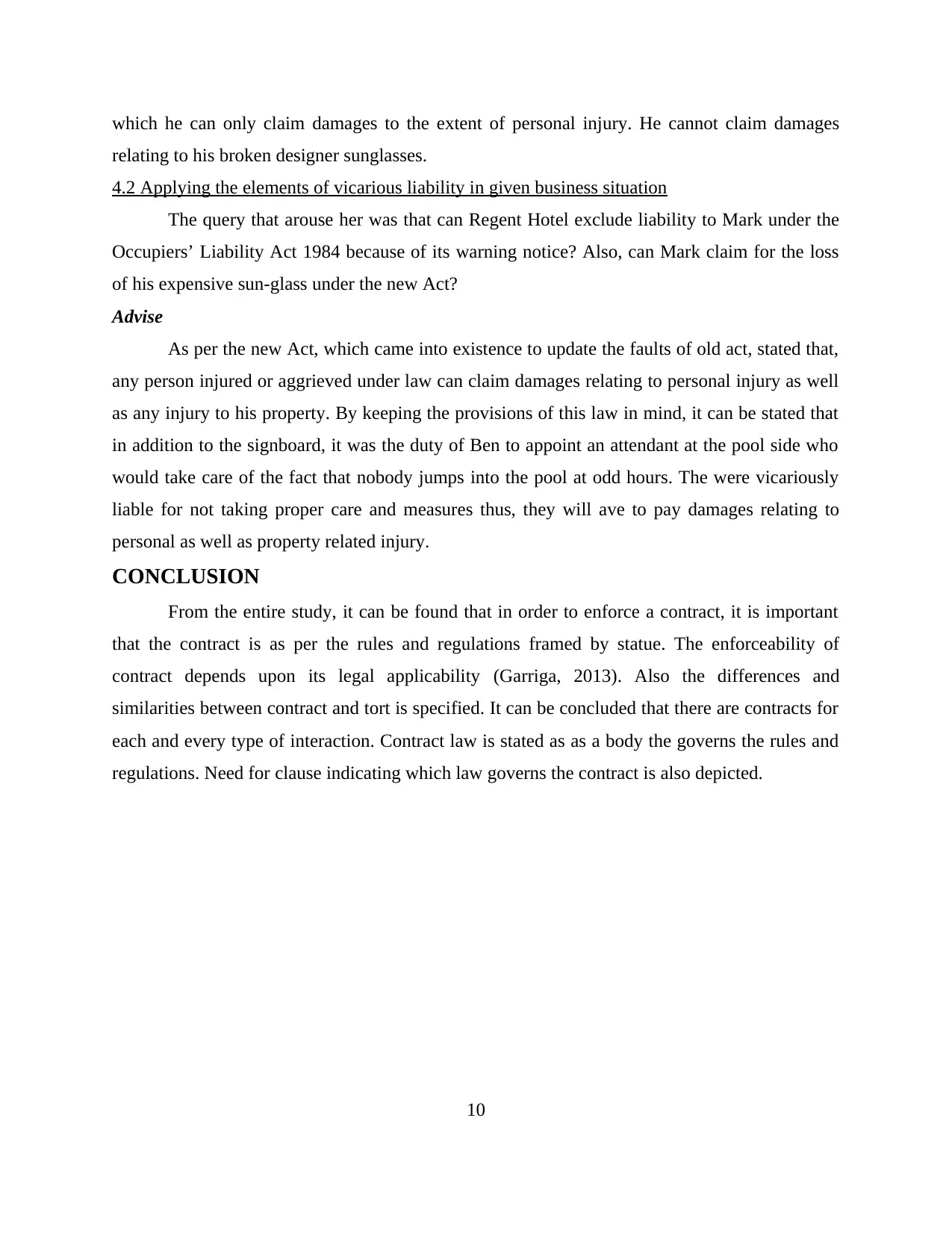
which he can only claim damages to the extent of personal injury. He cannot claim damages
relating to his broken designer sunglasses.
4.2 Applying the elements of vicarious liability in given business situation
The query that arouse her was that can Regent Hotel exclude liability to Mark under the
Occupiers’ Liability Act 1984 because of its warning notice? Also, can Mark claim for the loss
of his expensive sun-glass under the new Act?
Advise
As per the new Act, which came into existence to update the faults of old act, stated that,
any person injured or aggrieved under law can claim damages relating to personal injury as well
as any injury to his property. By keeping the provisions of this law in mind, it can be stated that
in addition to the signboard, it was the duty of Ben to appoint an attendant at the pool side who
would take care of the fact that nobody jumps into the pool at odd hours. The were vicariously
liable for not taking proper care and measures thus, they will ave to pay damages relating to
personal as well as property related injury.
CONCLUSION
From the entire study, it can be found that in order to enforce a contract, it is important
that the contract is as per the rules and regulations framed by statue. The enforceability of
contract depends upon its legal applicability (Garriga, 2013). Also the differences and
similarities between contract and tort is specified. It can be concluded that there are contracts for
each and every type of interaction. Contract law is stated as as a body the governs the rules and
regulations. Need for clause indicating which law governs the contract is also depicted.
10
relating to his broken designer sunglasses.
4.2 Applying the elements of vicarious liability in given business situation
The query that arouse her was that can Regent Hotel exclude liability to Mark under the
Occupiers’ Liability Act 1984 because of its warning notice? Also, can Mark claim for the loss
of his expensive sun-glass under the new Act?
Advise
As per the new Act, which came into existence to update the faults of old act, stated that,
any person injured or aggrieved under law can claim damages relating to personal injury as well
as any injury to his property. By keeping the provisions of this law in mind, it can be stated that
in addition to the signboard, it was the duty of Ben to appoint an attendant at the pool side who
would take care of the fact that nobody jumps into the pool at odd hours. The were vicariously
liable for not taking proper care and measures thus, they will ave to pay damages relating to
personal as well as property related injury.
CONCLUSION
From the entire study, it can be found that in order to enforce a contract, it is important
that the contract is as per the rules and regulations framed by statue. The enforceability of
contract depends upon its legal applicability (Garriga, 2013). Also the differences and
similarities between contract and tort is specified. It can be concluded that there are contracts for
each and every type of interaction. Contract law is stated as as a body the governs the rules and
regulations. Need for clause indicating which law governs the contract is also depicted.
10
Paraphrase This Document
Need a fresh take? Get an instant paraphrase of this document with our AI Paraphraser
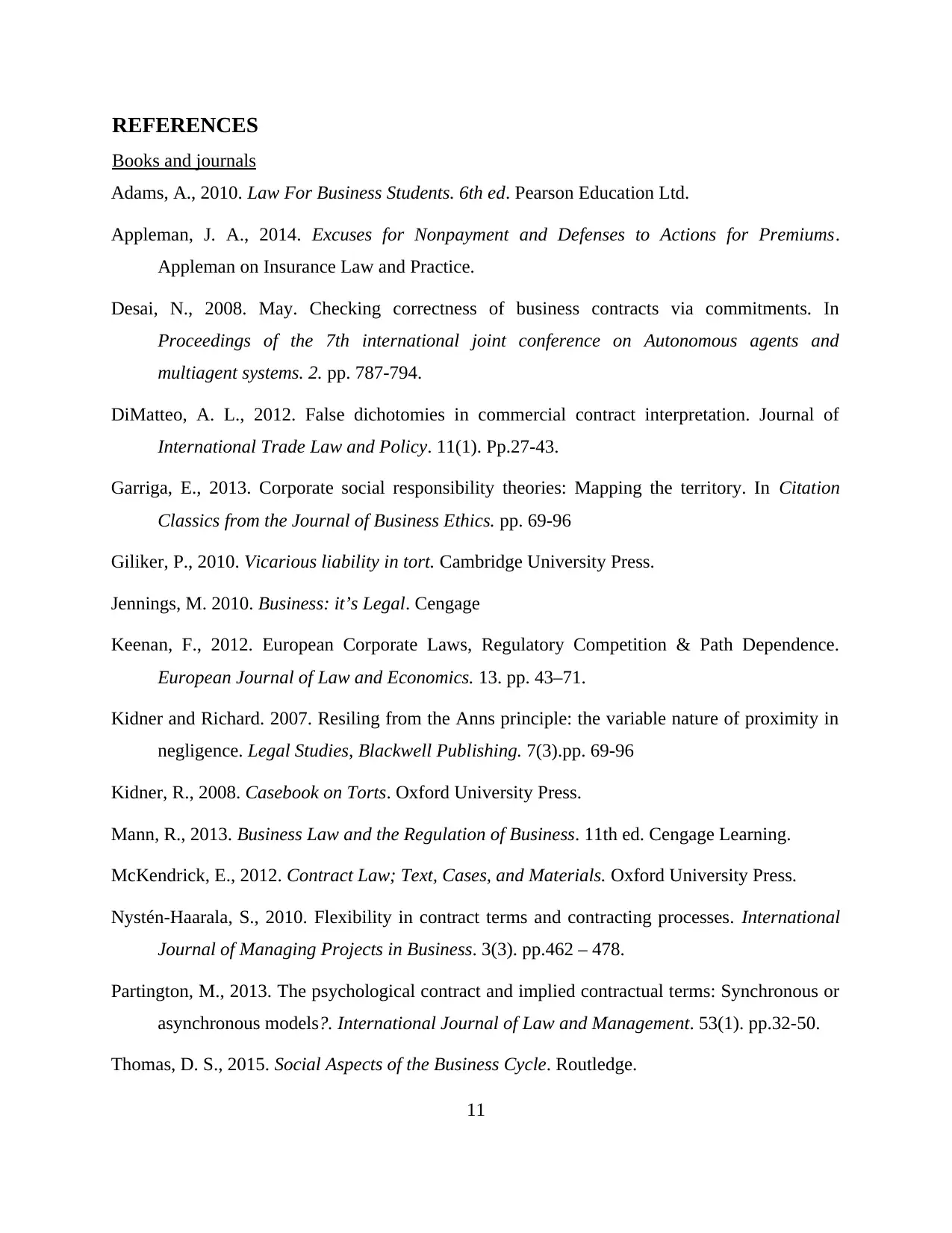
REFERENCES
Books and journals
Adams, A., 2010. Law For Business Students. 6th ed. Pearson Education Ltd.
Appleman, J. A., 2014. Excuses for Nonpayment and Defenses to Actions for Premiums.
Appleman on Insurance Law and Practice.
Desai, N., 2008. May. Checking correctness of business contracts via commitments. In
Proceedings of the 7th international joint conference on Autonomous agents and
multiagent systems. 2. pp. 787-794.
DiMatteo, A. L., 2012. False dichotomies in commercial contract interpretation. Journal of
International Trade Law and Policy. 11(1). Pp.27-43.
Garriga, E., 2013. Corporate social responsibility theories: Mapping the territory. In Citation
Classics from the Journal of Business Ethics. pp. 69-96
Giliker, P., 2010. Vicarious liability in tort. Cambridge University Press.
Jennings, M. 2010. Business: it’s Legal. Cengage
Keenan, F., 2012. European Corporate Laws, Regulatory Competition & Path Dependence.
European Journal of Law and Economics. 13. pp. 43–71.
Kidner and Richard. 2007. Resiling from the Anns principle: the variable nature of proximity in
negligence. Legal Studies, Blackwell Publishing. 7(3).pp. 69-96
Kidner, R., 2008. Casebook on Torts. Oxford University Press.
Mann, R., 2013. Business Law and the Regulation of Business. 11th ed. Cengage Learning.
McKendrick, E., 2012. Contract Law; Text, Cases, and Materials. Oxford University Press.
Nystén-Haarala, S., 2010. Flexibility in contract terms and contracting processes. International
Journal of Managing Projects in Business. 3(3). pp.462 – 478.
Partington, M., 2013. The psychological contract and implied contractual terms: Synchronous or
asynchronous models?. International Journal of Law and Management. 53(1). pp.32-50.
Thomas, D. S., 2015. Social Aspects of the Business Cycle. Routledge.
11
Books and journals
Adams, A., 2010. Law For Business Students. 6th ed. Pearson Education Ltd.
Appleman, J. A., 2014. Excuses for Nonpayment and Defenses to Actions for Premiums.
Appleman on Insurance Law and Practice.
Desai, N., 2008. May. Checking correctness of business contracts via commitments. In
Proceedings of the 7th international joint conference on Autonomous agents and
multiagent systems. 2. pp. 787-794.
DiMatteo, A. L., 2012. False dichotomies in commercial contract interpretation. Journal of
International Trade Law and Policy. 11(1). Pp.27-43.
Garriga, E., 2013. Corporate social responsibility theories: Mapping the territory. In Citation
Classics from the Journal of Business Ethics. pp. 69-96
Giliker, P., 2010. Vicarious liability in tort. Cambridge University Press.
Jennings, M. 2010. Business: it’s Legal. Cengage
Keenan, F., 2012. European Corporate Laws, Regulatory Competition & Path Dependence.
European Journal of Law and Economics. 13. pp. 43–71.
Kidner and Richard. 2007. Resiling from the Anns principle: the variable nature of proximity in
negligence. Legal Studies, Blackwell Publishing. 7(3).pp. 69-96
Kidner, R., 2008. Casebook on Torts. Oxford University Press.
Mann, R., 2013. Business Law and the Regulation of Business. 11th ed. Cengage Learning.
McKendrick, E., 2012. Contract Law; Text, Cases, and Materials. Oxford University Press.
Nystén-Haarala, S., 2010. Flexibility in contract terms and contracting processes. International
Journal of Managing Projects in Business. 3(3). pp.462 – 478.
Partington, M., 2013. The psychological contract and implied contractual terms: Synchronous or
asynchronous models?. International Journal of Law and Management. 53(1). pp.32-50.
Thomas, D. S., 2015. Social Aspects of the Business Cycle. Routledge.
11
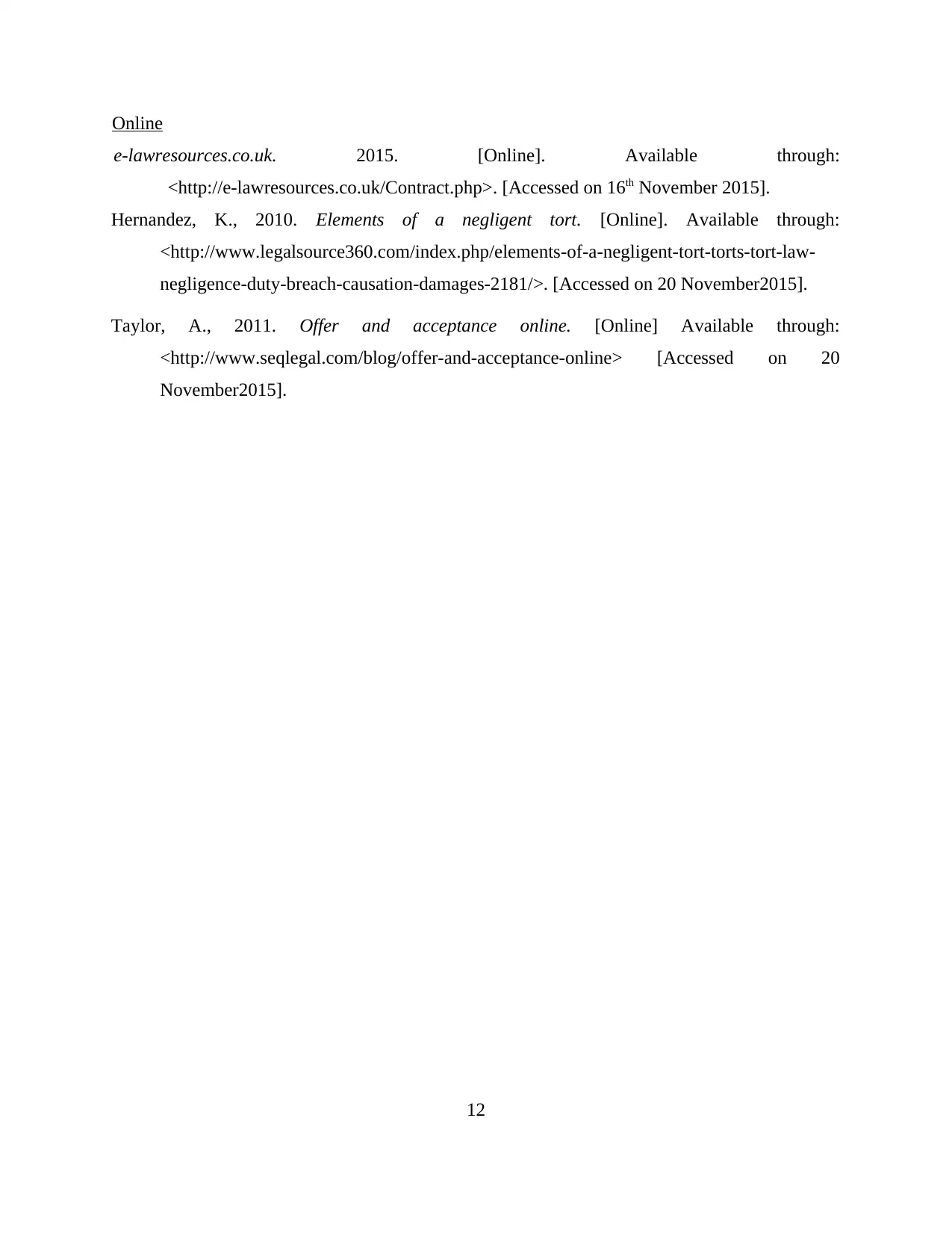
Online
e-lawresources.co.uk. 2015. [Online]. Available through:
<http://e-lawresources.co.uk/Contract.php>. [Accessed on 16th November 2015].
Hernandez, K., 2010. Elements of a negligent tort. [Online]. Available through:
<http://www.legalsource360.com/index.php/elements-of-a-negligent-tort-torts-tort-law-
negligence-duty-breach-causation-damages-2181/>. [Accessed on 20 November2015].
Taylor, A., 2011. Offer and acceptance online. [Online] Available through:
<http://www.seqlegal.com/blog/offer-and-acceptance-online> [Accessed on 20
November2015].
12
e-lawresources.co.uk. 2015. [Online]. Available through:
<http://e-lawresources.co.uk/Contract.php>. [Accessed on 16th November 2015].
Hernandez, K., 2010. Elements of a negligent tort. [Online]. Available through:
<http://www.legalsource360.com/index.php/elements-of-a-negligent-tort-torts-tort-law-
negligence-duty-breach-causation-damages-2181/>. [Accessed on 20 November2015].
Taylor, A., 2011. Offer and acceptance online. [Online] Available through:
<http://www.seqlegal.com/blog/offer-and-acceptance-online> [Accessed on 20
November2015].
12
⊘ This is a preview!⊘
Do you want full access?
Subscribe today to unlock all pages.

Trusted by 1+ million students worldwide
1 out of 12
Related Documents
Your All-in-One AI-Powered Toolkit for Academic Success.
+13062052269
info@desklib.com
Available 24*7 on WhatsApp / Email
![[object Object]](/_next/static/media/star-bottom.7253800d.svg)
Unlock your academic potential
Copyright © 2020–2025 A2Z Services. All Rights Reserved. Developed and managed by ZUCOL.





